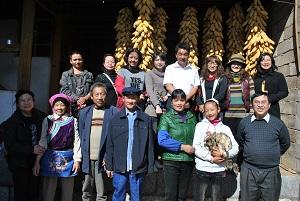Linguistic and cultural documentation of Sadu

Landing page image for the collection “Linguistic and cultural documentation of Sadu”. Click on image to access collection.
| Language | Sadu |
| Depositor | Xianming Xu, Bibo Bai, Yan Yang |
| Affiliation | Yuxi Normal University |
| Location | China |
| Collection ID | 0069 |
| Grant ID | MDP0209 |
| Funding Body | ELDP |
| Collection Status | Collection online |
| Landing Page Handle | http://hdl.handle.net/2196/14985dd0-3908-485e-9507-0f796f767831 |
Summary of the collection
Yuxi Municipality is located in the middle of Yunnan Province, at a distance of 88 kilometers from Kunming city, the provincial capital. Yuxi Municipality, with a total area of 15,285 km², consists of one district and eight counties under its jurisdiction, namely, Hongta District, Tonghai County, Jiangchuan County, Chengjiang County, Huaning County, Yimen County, Eshan Yi Autonomous County, Xinping Yi and Dai Autonomous County and Yuanjiang Hani, Yi and Dai Autonomous County. There are 25 nationalities with a total population of 2.276 million in Yuxi Municipality. They are Chinese, Yi, Hani, Dai, Hui, Bai, Mongolia, Miao, Lahu nationality groups, etc. Over 33 percent of the total population in the Yuxi Municipality territory is the minority nationalities.
Hongta District, where is the political, economic and cultural center has a population of 400,000, according to the 2009 census. There are 3 sub-districts, 6 towns, and 2 townships of Nationalities under the jurisdiction of Hongta District. They are Yuxinglu Sub-district, Fenghuanlu Sub-district and Yudailu Sub-district; Beicheng Township, Chunhe Township, Liqi Township, Dayingjie Township, Yanhe Township, Gaocan Township, Xiaoshiqiao Yi Nationality Township and Luohe Yi Nationality Township. The Sadu inhabit in Jianyuan village at Beicheng Township, Xincun and Dashuitang villages in Chunhe Township.
The three hamlets are located in east longitude 102°17′32″ and north latitude 24°08′30″, in the mountains between 1700 and 1900 meters above sea-level. The distances between the three hamlets range from 6 to 10 km. They are surrounded by Yi, Han, Hani and Hui as well as other minority nationalities. It is located in the high mountains, 6 km away from the Cluster seat, and 20 km away from Beicheng Township government headquarter, and 40 km away from Yuxi city seat. Xincun and Dashuitang are two of four hamlets at Boyi Village Cluster. They are 4 and 6 km away from the Cluster seat, and 12 and 18 km away from Chunhe Township government headquarter, and 20 and 26 km away from Yuxi city seat, respectively.
The total population in Chunhe Township Administrative jurisdiction is 55,368. Of them 5,310 are Yi; 996 are the Sadu, officially Bai.
The population in three hamlets are 1756, the Sadu are 1505, which comprises 85.7 percent. The Yi are 175 and Han are 21, which comprise 9.97 and 1.2 percent, respectively. Other minority nationalities are only 5, which comprise 0.3 percent, who came to the village by marriage.
Group represented
Sadu
Language information
It was identified as a newly-discovered language which belongs to one of Yi branch languages of Tibeto-Burman language family of Sino-Tibetan Language Phylum, which parallels with the Hani, Yi, Lisu, Jinuo and Lahu language etc.
Other information
There is almost no literature on the Sadu ethnic group. The historical background we acquired was mainly from oral narration delivered by the elders in the three hamlets. According to limited local Chinese records and some elders’ oral narrations, it was said that the Li clan in Jiaoyuan and the Bi clan in Dashuitang hamlet moved from Hetaoyuan Township in Kunyan County and Baofeng Township of Jinning County during the time of the Qing Dynasty. Originally they belonged to a sub-branch of Yi who claimed to be “Samodu”, whose ancestors were referred to “Ximodi” in the Tang Dynasty, and as “Ximotu” in the Yuan Dynasty. This group of people was named “Bailuoluo Samodu” after the Ming Dynasty. Nowadays, the villagers of the Li clan acknowledge that they are the descendants of Dali Bai nationality, however. They call themselves Sadu. Yet they use different names to distinguish themselves from one hamlet to another. The people from Xincun village call themselves Suonapo. The people from Tashuitang call themselves Tatapo; The people from Jiaoyuan claimed themselves Lilepo. They all were referred as Bai-Yi before 1958. They were designated by the Government as Bai nationality in 1958. Nevertheless, the language is very unique. It is neither intelligible to Yinyuan Bai, nor Dali Bai, nor local Yi. Sadly, we found that the descendants of preceding generations in Hetaoyuan and Baofeng Townships have now all shifted to Chinese. Therefore, this group of people was redefined as the Sadu.
According the identification, the Sadu language belongs to one of the languages of the Tibeto-Burman branch of the Sino-Tibetan language family. However, the Sadu language is a lesser-known language. It is not intelligible to Bai, nor the neighboring Yi. It is necessary to redefine the genetic affiliation explicitly based on core words, phonology, words formation and grammar analysis as well as comparison with related languages.
Acknowledgement and citation
To refer to any data from the collection, please cite as follows:
Xu, Xianming, Bibo Bai & Yan Yang. 2012. Linguistic and cultural documentation of Sadu. Endangered Languages Archive. Handle: http://hdl.handle.net/2196/00-0000-0000-000E-2C86-5. Accessed on [insert date here].


